We don't forget
Below are some of the events we organized with the Antwerp Young Minds.
Some of the lectures were recorded. The link to the video is in the description of the lecture.
2024-11-21 Paul Midgley - 30 Years of Electron Diffraction: A Personal Journey Through Reciprocal Space
Speaker
University of Cambridge
Title
30 Years of Electron Diffraction: A Personal Journey Through Reciprocal Space
Abstract
Although invented nearly 100 years ago, the transmission electron microscope (TEM) remains a superbly powerful instrument for the study of materials. Since the 1990s the capability of the TEM has increased enormously, enabling a wide range of experiments to be undertaken, based around imaging, spectroscopy and diffraction. The talk will focus primarily on the last of these three: diffraction, using results from the speaker's research over the past 30 years A modern TEM can be used as a remarkably sensitive high-resolution electron ‘diffractometer’―using nanometer-sized electron beams to determine, for example, local atomic structure, bonding and molecular vibrations. A more recent technique is the combination of electron diffraction with scanning TEM and tomography, to produce large ‘multi-dimensional’ data sets. By using new tools like machine learning, we can reveal remarkable high resolution microstructural details not easily seen with other techniques. In particular, this can be applied to challenging ‘beam-sensitive’ or ‘soft’ materials, such as polymers, molecular solids and hybrid inorganic-organic materials. The talk will end with a brief look at what might lie in the future for electron diffraction, and for TEM in general.
Recording
The recording can be found at this link.
Pictures
Have a look at the poster here. The pictures will be coming soon.
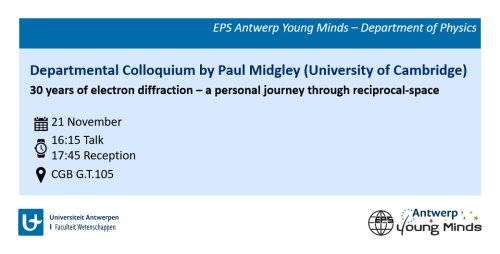
2024-10-09 Thesisbeurs: Master -en bachelorproef fysica
Tijdens deze informatiesessie geven we de praktische informatie over de bachelor- en masterproef, en worden de verschillende onderzoeksgroepen van het Departement Fysica voorgesteld. We sluiten af met een receptie, waar onderzoekers een posterpresentatie geven over hun onderzoek, en waar je meer uitleg kan vragen over mogelijke thesisonderwerpen. Heb je nog vragen over je thesisonder-werp of wil je inspiratie opdoen? Kom dan zeker!
Woensdag 9 oktober 2024
14h00 D.N.008 Presentaties
16h00 D.N.008 Postersessie met receptie
Aanbevolen voor 3de bachelor- en 1ste masterstudenten fysica.
Opnames zijn beschikbaar gesteld voor de studenten via Blackboard.
2024-04-18 Alumni Evening
Speaker
Annelies De wael, Policy Officer, Flemish government (EWI)
Frédéric Desclée – Data Engineer, Vectr Consulting
Steven Hens, Project Manager, Rewire Space
Martine De Mazière – Director General, Royal Belgian Institute for Space Aeronomy
Title
Alumni Evening
Pictures
Have a look at the poster and the photos.
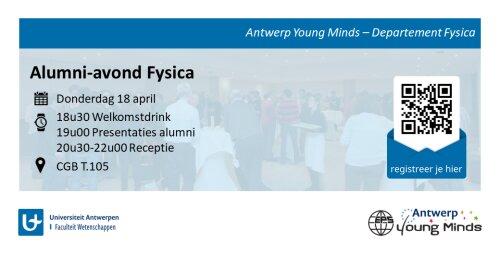
2024-03-06 Quantum Computing Workshop II
Speaker
IBM Quantum
Title
Quantum Computing Workshop II
Abstract
The Antwerp Young Minds, in collaboration with Eric Michiels from IBM Quantum, are once again organizing a quantum computation workshop. We have taken your feedback into account and strived for a more interactive workshop focusing on applications. With joy we present you the following overview of topics:
- Quantum computing & Qiskit: intro
- "Hello World": Qiskit guided exercise
- Quantum Adder: Qiskit exercise
- Quantum algorithms and their complexity
- Quantum teleportation: proof & Qiskit exercise
- Bernstein-Vazirani algorithm: proof & Qiskit exercise
Halfway there will be a break with coffee, tea and cookies.
To avoid problems with local installations we will be using IBM's online platform. For this an IBM ID is necessary and can be created through the following link: https://quantum.ibm.com/. Afterwards, you can delete your account if you wish.
The workshop will still be on an introductory level and thus accessible to everyone, regardless of whether the first workshop was followed.
When? March 6th, 9h-12h30Where? Campus Groenenborger, building Z, G.Z.445 (+G.Z.446)
Pictures
Have a look at the poster and the photos.
Video
This lecture was recorded and is available on YouTube.
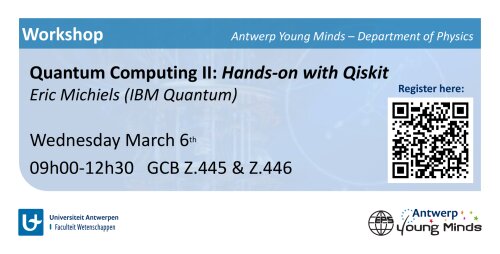
2024-02-19 Zotero workshop
Speaker
University of Antwerp
Abstract
Dealing with references is a fundamental part of any research project, be it a bachelor thesis, master thesis or PhD project. For this, it is a very good idea to use a reference manager like Zotero. This allows you to
Keep all your references in one place
Easily retrieve bibliographic data from new references
Manage and automatically download associated PDFs
Generate bibliographies in LaTeX or Word
This workshop will guide you through the installation of Zotero and the required plug-ins, and will show you how to use all the features listed above. This will make managing references much more easy and enjoyable.
Accompanying files
The files required for the workshop, containing an installation guide can be found in this Dropbox folder.
Pictures
Have a look at the poster and the photos.
Video
This lecture was recorded and is available on YouTube.
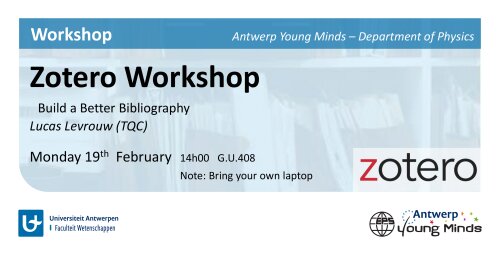
2024-01-25 Salomé Forel - Recent Advances and Key Challenges in Single-Wall Carbon Nanotubes
Speaker
Prof. dr Salomé Forel
Title
Recent Advances and Key Challenges in Single-Wall Carbon Nanotubes: From Synthesis to Characterization, Filling Process and Sensing Capabilities
Abstract
Single-wall carbon nanotubes (SWCNTs) are renowned for their outstanding charge carrier mobility, optical, thermal, and mechanical properties. The convergence of these attributes with their nanometer-scale diameter makes them highly promising for the development of ("); border-bottom: 1px solid transparent; background-size: 5px; color: rgb(0, 0, 0); font-style: normal; font-weight: normal; letter-spacing: 0px; orphans: 2; text-align: justify; text-indent: 0px; text-transform: none; widows: 2; word-spacing: 0px; -webkit-text-stroke-width: 0px; white-space: normal; background-color: rgb(237, 235, 233); text-decoration-thickness: initial; text-decoration-style: initial; text-decoration-color: initial; font-size: 15pt; font-family: Calibri, Calibri_EmbeddedFont, Calibri_MSFontService, Calibri_MSFontService, Verdana, Sans-Serif; font-kerning: normal; line-height: 13px; vertical-align: -0.302444px;">opto)-electronic devices, presenting the challenge of achieving miniaturization without compromising performance. Beyond their inherent characteristics, SWCNTs feature a hollow core that can be filled with various molecules, resulting in unique one-dimensional hybrids that integrate the properties of the nanotube with those of the encapsulated molecule. This presentation will highlight recent advances and key challenges on nanotubes, both in synthesis, characterizations, filling progress, and sensing capabilities of these unique objects.
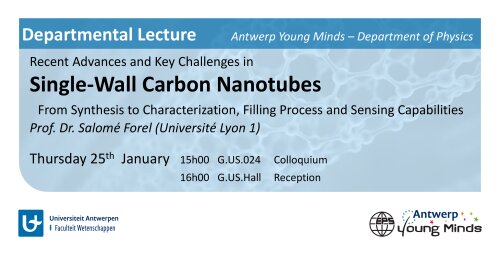
2023-12-20 Trip to ETpathfinder
2023-11-23 Julia Workshop
Speaker
University of Antwerp
Title
Julia Workshop, Compute the future
Abstract
In 2012, the first version of a new programming language called Julia was launched. With a large appreciation for many different coding paradigms, the goals that the founders had set for this new language were, to say the least, ambitious. “We want a language that's open source, with a liberal license. We want the speed of C with the dynamism of Ruby. … We want something as usable for general programming as Python, as easy for statistics as R, as natural for string processing as Perl, as powerful for linear algebra as MATLAB, …” [1]. Yet, the first stable version, released only in 2018, had already met most of these objectives. Subsequent releases resulted from the motivation to continuously improve. The result today is an easy-to-use, flexible, and yet performant coding language that is well on its way to become the new standard for scientific computing.
In this workshop we will explore the fundamentals of the Julia language. How is it different from what you use now? What does it offer more? Is it easy to learn? We will cover it all! Following a short introduction, you will have to chance to explore the base functions and commands. Your newly gained insights will come in handy in the second part, where you can apply them to some more advanced examples.
[1] J. Bezanson, S Karpinski, V.B. Shah, and A. Edelman, Why we created Julia, The Julia Language Blog, https://julialang.org/blog/2012/02/why-we-created-julia/, (2012).
Pictures
Have a look at the poster and the photos.
You can find the presentation and assignments from the workshop here.
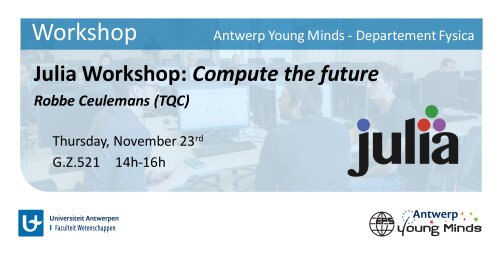
2023-10-25 Thesis Fair
Title
Thesis Fair
Abstract
Op deze informatiesessie leggen we eerst de administratieve stappen uit voor de masterproef fysica. Hierna stellen we de verschillende onderzoeksgroepen van het departement fysica voor. De onderzoekers uit deze groepen geven mogelijke onderwerpen voor een masterproef. Aan het einde volgt een receptie, waarbij de onderzoekers een posterpresentatie geven over hun eigen onderzoek. Heb je nog vragen over je thesisonderwerp of wil je inspiratie opdoen? Kom dan zeker!
Pictures
Have a look at the poster and the photos.
You can find the presentations from the workshop here
Video
This lecture was recordedand is viewable with an UAntwerp account .
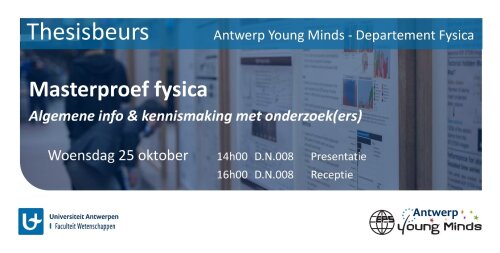
2023-10-06 Quantum Computing Workshop
Speaker
IBM Quantum
Title
Quantum Computing Workshop
Abstract
Quantum information and computation are becoming more popular in various industries. With this workshop we want to offer you a first hands-on experience in this field. You will obtain the tools necessary you need to know to start your quantum endeavors. Everyone is welcome, physics, mathematics or computer science students/researchers. The EPS Antwerp Young Minds will provide some nice coffee and tea during the workshop. You can drop-in the day itself, but we kindly ask to enroll with the QR code on this poster.
Pictures
Have a look at the poster and the photos.
Video
This lecture was recorded and is available on the mediasite.
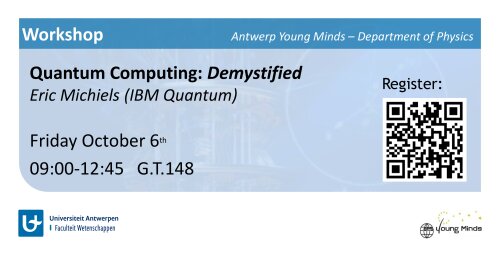
2023-08-29 Aldo Zarbin - Preparation and Processing of Multicomponent Materials at Liquid/Liquid Interfaces
Speaker
Federal University of Paraná
Title
Preparation and Processing of Multicomponent Materials at Liquid/Liquid Interfaces: Thin Films for Enlarging Technological Applications
Abstract
The interface between immiscible liquids to synthesize, stabilize and process complex materials as transparent and conductive thin films has a huge potential to be applied in different technological systems and devices. Examples of multicomponent materials combining carbon nanostructures (nanotubes, graphene), 2D materials, Prussian blue analogues, metal nanoparticles and conducting polymers will be presented. Unique preparation routes will be highlighted, as well as its structure/properties relationship, thin film deposition over several solid substrates and application in flexible and transparent aqueous metal-ion batteries, supercapacitors, electrochromic devices, solar cells, as transparent electrodes, and as catalysts.
See you there!
The Antwerp Young Minds team
Pictures
Have a look at the poster and the photos.
Video
This lecture was recorded and is available on YouTube.
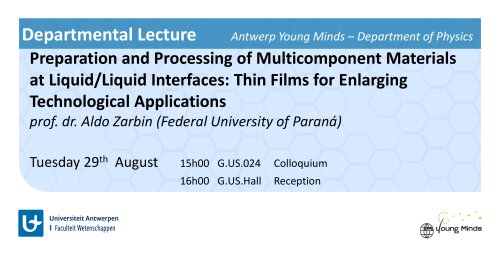
2023-06-26 Subir Sachdev - Spin Liquids & phase diagram of cuprates
Speaker
Harvard University
Title
Spin Liquids & phase diagram of cuprates
Abstract
During the last week of June, Prof. Dr. Subir Sachdev (Harvard University) will visit several universities in Belgium. Together with him and TQC, we are organizing a departmental lecture on spin liquids and the phase diagram of cuprate superconductors. We cordially invite you to this lecture on Monday, June 26th, in G.US.024 at 15:00. Afterwards, there will be a reception where you can discuss and chat with fellow co-workers and friends. This lecture is mostly aimed at researchers of the Department of Physics, but naturally everyone is welcome to come and listen to this renowned professor.
See you there!
The Antwerp Young Minds team
Pictures
Have a look at the poster.
Video
This lecture was recorded and is available on YouTube.
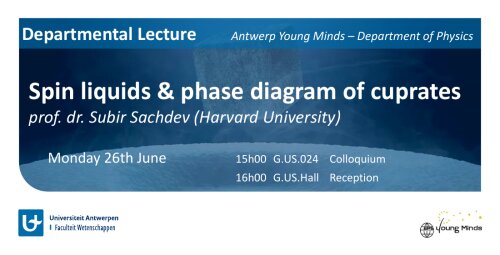
2023-03-15 Nir Navon - Ultracold fermions in an optical box
Speaker
Prof. Dr. Nir Navon
Yale University
Title
Ultracold fermions in an optical box
Abstract
For the past two decades harmonically trapped ultracold atomic gases have been used with great success to study fundamental many-body physics in flexible experimental settings. However, the resulting gas density inhomogeneity in those traps makes it challenging to study paradigmatic uniform-system physics (such as critical behavior near phase transitions) or complex quantum dynamics.The realization of homogeneous quantum gases trapped in optical boxes has marked a milestone in the quantum simulation program with ultracold atoms [1]. These textbook systems have proved to be a powerful playground by simplifying the interpretation of experimental measurements, by making more direct connections to theories of the many-body problem that generally rely on the translational symmetry of the system, and by altogether enabling previously inaccessible experiments. I will present a set of studies with ultracold fermions trapped in a box of light. This platform is particularly suitable to study problems of Fermi-system stability, of which I will discuss two cases: the spin-1/2 Fermi gas with repulsive contact interactions [2], and the three-component Fermi gas with spin-population imbalance [3]. Both studies lead to surprising results, highlighting how spatial homogeneity not only simplifies the connection between experiments and theory, but can also unveil unexpected outcomes.
[1] N. Navon, R.P. Smith, Z. Hadzibabic, Nature Phys. 17, 1334 (2021)
[2] Y. Ji et al., Phys. Lev. Lett 129, 203402 (2022)
[3] G.L. Schumacher et al., arXiv:2301.02237
Pictures
The pictures of the event are available on Flickr.
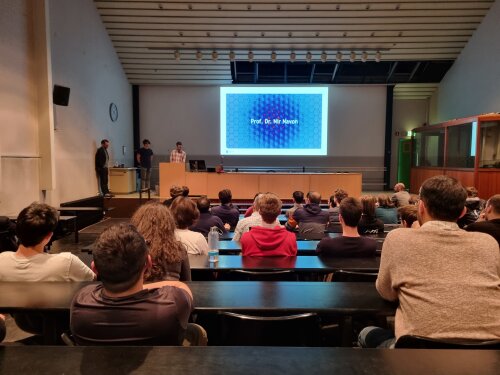
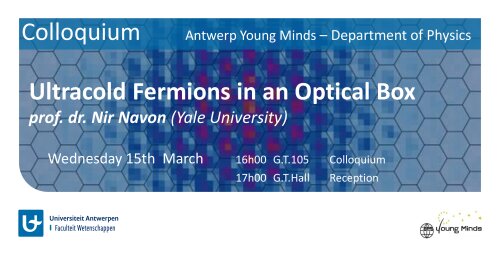
2022-10-04 Informatiesessie: Masterproef fysica
Masterproef Fysica
Algemene info & kennismaking met onderzoek(ers
Op deze informatiesessie leggen we eerst de administratieve stappen uit voor de masterproef fysica. Hierna stellen we de verschillende onderzoeksgroepen van het departement fysica voor. De onderzoekers uit deze groepen geven mogelijke onderwerpen voor een masterproef. Aan het einde volgt een receptie, waarbij de onderzoekers een posterpresentatie geven over hun eigen onderzoek. Heb je nog vragen over je thesisonderwerp of wil je inspiratie opdoen? Kom dan zeker!
Dinsdag 4 oktober
14h00 G.T.135 Presentatie
15h00 G.T.135 Receptie
Sterk aanbevolen voor 3e bachelor- en 1e masterstudenten fysica.
Pictures
The pictures of the event are available on Flickr.
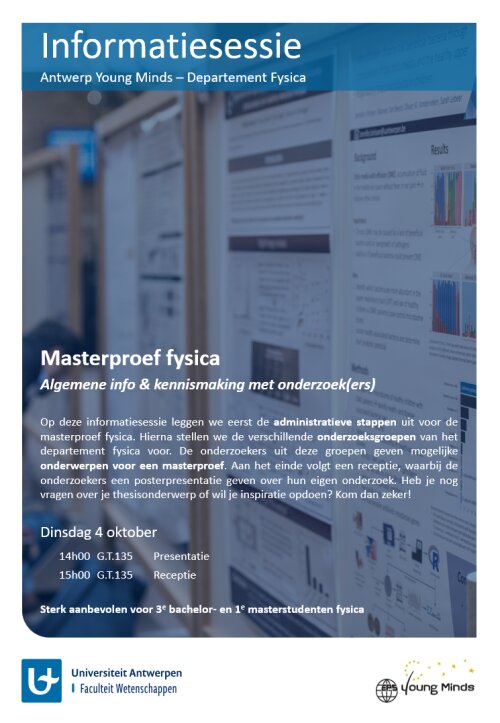
2022-05-20 AiiDA: computational infrastructure
Friday 20th May
Speaker
Title
AiiDA: computational infrastructure
Abstract
AiiDA is a computational infrastructure for running scientific workflows, with a special focus on robustness and tracking the full history of the calculations. AiiDAlab is a Jupyter-based web-platform that enables computational scientists to package AiiDA workflows, computational environments, and associated graphical user interfaces, and share them with their collaborators and peers. The presentation will focus on explaining the key concepts of AiiDA, along with a short demonstration of the AiiDAlab Quantum ESPRESSO app. In the afternoon we will have two practical sessions: one that helps computational scientists learn the basics of AiiDA, and one that focusses on AiiDAlab, giving both experts and laymen a chance to test this useful tool and provide feedback.
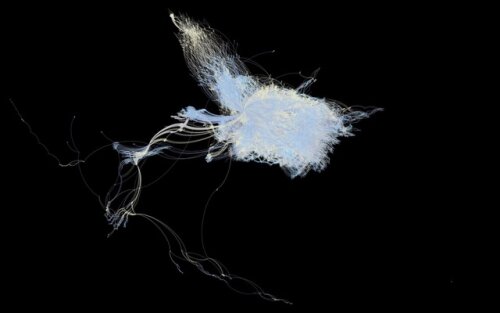
2019-06-13 Marc De Graef - Music by the Numbers: Why do certain musical chords sound better than others?
Speaker
Prof. Dr. Marc De Graef
Carnegie Mellon University
Title
Music by the Numbers: Why do certain musical chords sound better than others?
Abstract
Music is, fundamentally, a progression in time of single or multiple frequencies, commonly known as "tones". As we listen to music, some combinations of tones may evoke certain emotions; happy or sad feelings, for instance, are often associated with major and minor chords, respectively. It turns out that those emotional responses tend to be independent of age and culture; therefore, the cause must lie in the underlying physics of sound and how we perceive sound. In this presentation, we will begin by defining the basic notions of sounds (frequency, harmonics or overtones, amplitude, timbre, ...), and we will use the fact that the human ear has a logarithmic response to frequencies to explain why there are 12 intervals in an octave (i.e., 5 black + 7 white keys on a keyboard) in Western music. Then we "derive" a model for the various musical scales and introduce the concepts of tension, harmony, consonance, and sonority. We will present simple mathematical models for all these musical concepts. No extensive prior knowledge of music is required to attend this talk; all concepts will be introduced as needed. Throughout the presentation, we will illustrate several concepts with a few finger-picking guitar pieces.
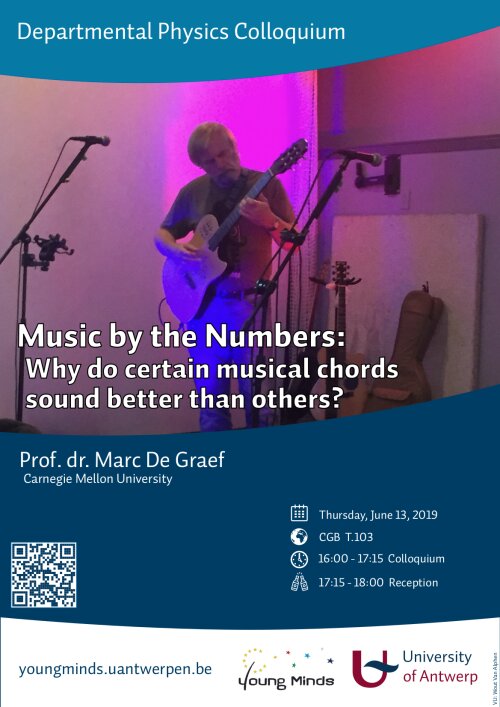
2019-05-20 Jean-Pascal van Ypersele - Climate Change: From modelling to school strikes
Speaker
Prof. dr. Jean-Pascal van Ypersele
Université catholique de Louvain
Title
Climate Change: From modelling to school strikes
Abstract
Humanity, particularly the richest part of it, continues to use the atmosphere as a dump site for the results of fossil fuel combustion. We send about 50 billion tonnes of CO2 and other greenhouse gases into the atmosphere every year. Between 15 and 40% of that amount will still be present in the atmosphere in a thousand years from now. This increases the thickness of the thermal insulating layer around the planet. But the planet does not need any additional insulation: global temperature and the intensity of associated extreme events have increased already too much. This insulation metaphor helps to understand, without any complex climate model, why it is so essential to reduce emissions to “net zero” ASAP! If we don’t do that, we will increase the insulation layer thickness, and suffocate underneath.
The IPCC Special Report on 1.5°C Global Warming, a report adopted by all governments in October 2018, has described at length the importance for both humanity and ecosystems of not overshooting the 1.5°C target of the Paris Agreement. One of the many reasons is the fact that ice sheets are melting at a faster rate than expected just a few years ago, and the long-term consequences for sea level are severe. It is a question of survival for a large part of humanity (and many other species)!
Much of the above knowledge is based on models representing the physics of the climate system. This talk will review some key aspects of this modelling, and discuss some of their implications.
Young people like Greta, Anuna, Kyra, or Bo, and the many others who are increasingly speaking truth to power, including through school strikes, have understood the severity of the situation we are in. They are asking our generation: “Which world do you want to leave us”?
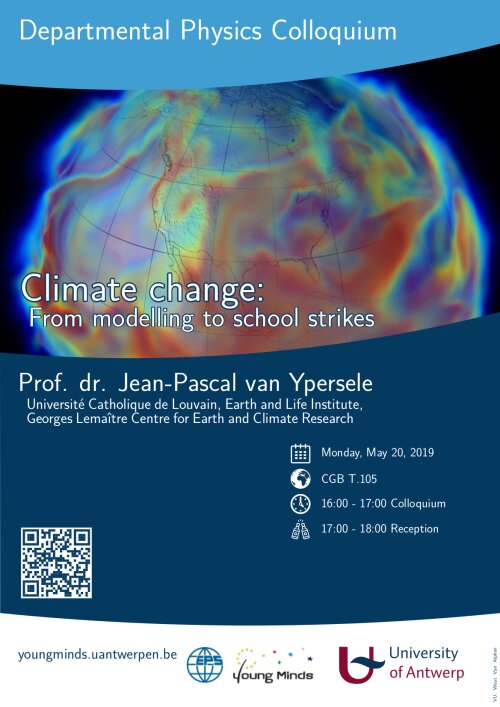
2019-05-10 Workshop - Tikz & PGFPlots
Speaker
Title
Tikz & PGFPlots
Abstract
TikZ is a LaTeX package that enables you to draw vector graphics directly into your document. This creates nice figures with the same layout as the rest of the TeX output. With PGFPlots, it is possible to use the power of TikZ to make publication-quality plots in an easy way. It can draw functions or use user-supplied data to make figures that are fully customisable to your needs.
In this workshop, we will start off with the basics of using TikZ to draw simple figures and Feynman diagrams. After this, we will introduce PGFPlots and how this can help to make plots directly into LaTeX.
Registration is free. There will be a short coffee break as well as some drinks afterwards to provide an opportunity for discussion and getting to know your colleagues at the department.
Friday, May 10, 2019
G.Z.421
14:00 - 17:00 Workshop
17:00 - 18:00 Reception
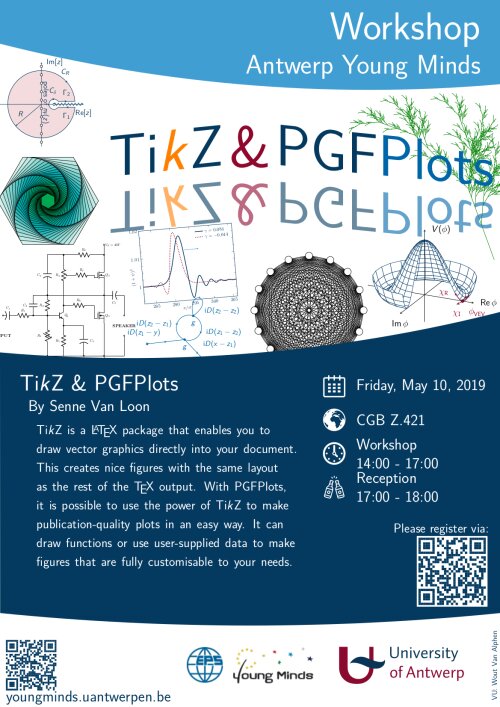
2019-05-03 Alumni avond fysica
Deze avond is voor onderzoekers en studenten het moment bij uitstek om in contact te komen met fysici die actief zijn buiten de academische wereld. Voor de alumni is deze avond bovendien een mooie gelegenheid om oude bekenden terug te zien en de nieuwe garde fysici te leren kennen.
Naar goede gewoonte zullen enkele alumni ons in een korte reeks presentaties vertellen waar een diploma fysica hen op professioneel vlak naartoe heeft geleid. Aansluitend wordt aan iedereen een uitgebreide receptie aangeboden.
De toegang is gratis, maar registreren is verplicht. Gelieve in te schrijven voor 30 april.
Programma
18u30: Welkomstdrink
19u00: Presentaties van alumni
- Katrijn Verhasselt: Wetenschappelijk medewerker bij de Koninklijke Sterrenwacht van België
- Jef Aernouts: Product manager bij Farmdesk
- Herman Van Slambrouck: Leerkracht in het secundair onderwijs
- Dorian Appeldoorn: R&D engineer bij Vision++
20u30: Receptie
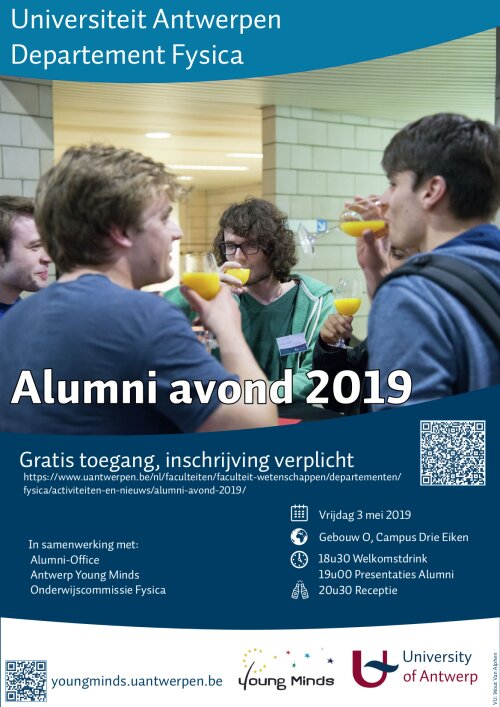
Pictures
The pictures of the event are available on the Beeldbank of UAntwerp.
2019-03-22 Workshop - Jupyter Lab
Speaker
Dr. Magnus Nord
Electron microscopy for Materials science, University of Antwerp, Belgium
Title
Introduction to Jupyter Lab
Abstract
JupyterLab is an interactive development environment for working with notebooks, code and data. Additionally, JupyterLab enables you to use text editors, terminals, data file viewers, and other custom components side by side with notebooks in a tabbed work area. It is a powerful tool for scientists to perform their data analysis, that is easily shareable with collaborators or students.
In this workshop we will help set up the python environment for running jupyter lab and installing extensions. Once everyone has their notebook up and running, we'll expain some of the basic elements of writing your own notebooks and perform some simple exercises for visualizing data using matplotlib . Finally, we'll also help introduce some interactive elements using the ipywidgets extension.
The workshop's material can be found on github.
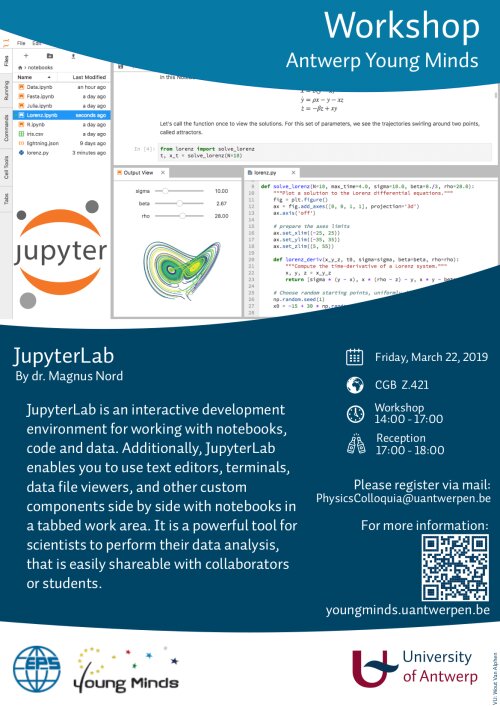
2018-10-25 Frank Verstraete - Quantum many body physics in the age of quantum information
Speaker
Title
Quantum many body physics in the age of quantum information
Abstract
Quantum information theory has provided a new language for describing quantum correlations and entanglement. In this colloquium, it will be highlighted how the language of qubits and EPR pairs can be used to tackle the ubiquitous quantum many body problem. Topics covered will be entanglement, frustrated many body systems, quantum tensor networks and topological quantum order.
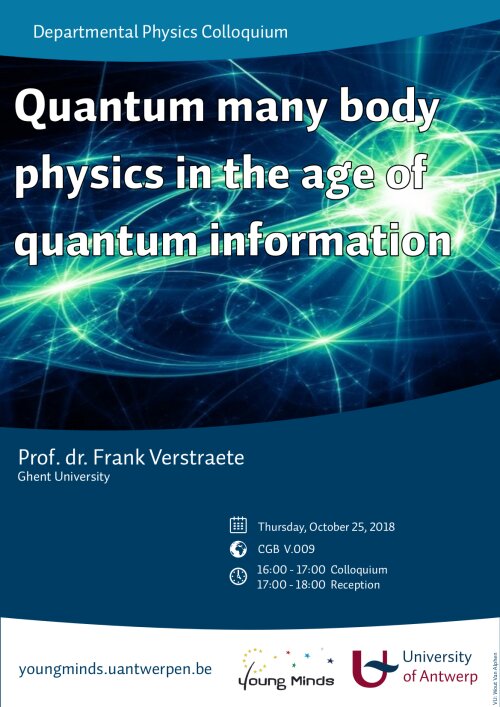
2018-04-11 Filmavond - KwantumRevolutie
De Vlaamse documentaire "Kwantumrevolutie" is niet alleen een begrijpelijke introductie in de fascinerende wereld van de kwantumfysica, maar geeft ook een unieke kijk op de geschiedenis van deze uiterst intrigerende wetenschap en haar impact op de wereld van vandaag. Bekijk de trailer hier.
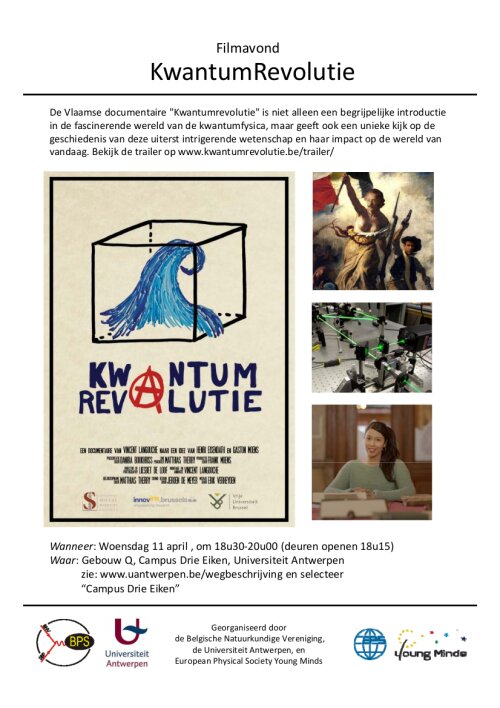
18u15 - 20u00
Woensdag 11 april 2018
Mede georganiseerd door de Belgische Natuurkundige Vereniging
2018-02-15 Erik Verlinde - From emergent gravity to the dark universe
Speaker
Title
From emergent gravity to the dark universe
Abstract
In most situations gravity is well described by the laws of Newton or Einstein’s general relativity. The observed deviations from these laws in galaxies and galaxy clusters are commonly seen as evidence for the presence of unseen dark matter particles. But logically speaking these deviations can also be due to a change in the way gravity works in these circumstances. In the past few years insights from black hole physics and string theory have revealed a deep connection between gravity and concepts of quantum information theory. A central role in these developments is played by the Bekenstein-Hawking formula for the entropy of black holes. Currently a new theoretical framework is being developed in which gravity emerges from the microscopic quantum information that is underlying space-time. In this new framework the gravitational laws are derived from a quantum version of the first law of thermodynamics applied to the entanglement entropy of the vacuum. We will argue that in a universe with positive dark energy the vacuum entanglement entropy receives an extra contribution that leads to a modification of the emergent laws of gravity compared to general relativity. We provide observational evidence for the fact that this modification explains the observed phenomena in galaxies and clusters currently attributed to dark matter.
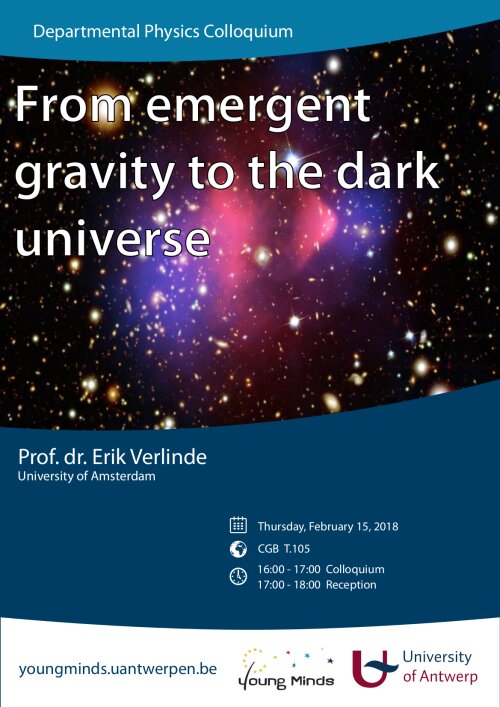
2017-12-13 Alfons Van Blaaderen - Self-assembly of particles
Speaker
Prof. dr. Alfons Van Blaaderen
Title
Surprises in the self-assembly of particles
Abstract
When metal or semiconductor nanoparticles are brought into close enough contact, the resulting collective properties of these materials can be as different as individual silicon atoms are from their 3D semiconductor counterpart. Self-assembly is an inherently cheap and powerful way to arrive at such 3D structures, which are also referred to as colloidal crystals. By stopping the self-assembly at controlled ‘supraparticle’ sizes, one gains even more control over the properties of these structures. In this talk, we will show fundamental insights about self-assembly into a spherical confinement and how these insights extend to particles with more complex shapes such as cubes, plates, rods and binary mixtures of nano-particles. We will show that this way of hierarchical self-assemby is useful to tailor optical properties as well. In order to arrive at quantitative real-space analysis of the supraparticles, new methodologies of particle tracking continuously have to be developed.
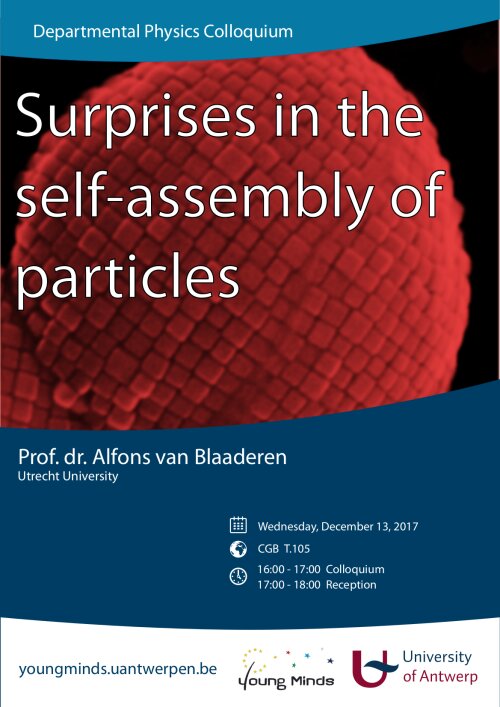
Pictures
The pictures of the event are available on Flickr.
2017-05-05 Alumni avond fysica
De alumni-avond Fysica van de Universiteit Antwerpen is voor onderzoekers en studenten van het Departement Fysica het moment bij uitstek om in contact te komen met fysici die actief zijn buiten de academische wereld. Bovendien biedt deze avond aan alle alumni van de richting de kans om oude bekenden terug te zien en de nieuwe garde fysici te leren kennen.
18u30: Welkomstdrink
19u00: Presentaties van alumni
- Maarten Baeten: Validator bij Argenta
- Jan Buytaert: Senior System Engineer bij Verhaert
- Anke Van Averbeke: Leerkracht fysica in het secundair onderwijs
- Senne Van Rompaey: Junior ICT Analyst bij Fluxys
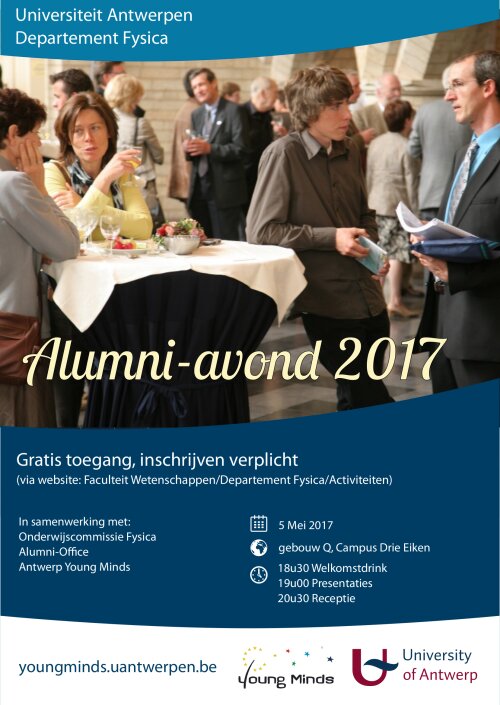
Pictures
The pictures of the event are available on Flickr.
2017-03-07 Jean Dalibard - Topology in atomic Flatland
Dear fellow physicists,
It is our pleasure to announce the next Departmental Physics Colloquium. On Tuesday, March 7, 2017, Prof. dr. Jean Dalibard from Collège de France and Laboratoire Kastler Brossel will present a talk entitled "Topology in atomic Flatland", on work closely related to the 2016 Nobel Prize in Physics. The abstract and practical information are included below.
We hope to see you all there.
Speaker
Title
Topology in atomic Flatland
Abstract
The physics of many-body systems strongly depends on their dimensionality. For example, in a two-dimensional world, most standard phase transitions towards an ordered state of matter would not occur, because of the increased role of fluctuations. However, non-conventional "topological" transitions can still take place, as understood initially by Kosterlitz and Thouless.
During the last decade, a novel environment has been developed for the study of low-dimensional physics. It consists of cold atomic gases confined in tailor-made light traps, forming thus a thin layer of material particles. In this talk, we will review some key aspects of these quantum 2D gases, such as their transition to a superfluid state. We will also address other topology-related effects in these systems, in relation with the creation of artificial gauge fields and quantum-Hall type phenomena.
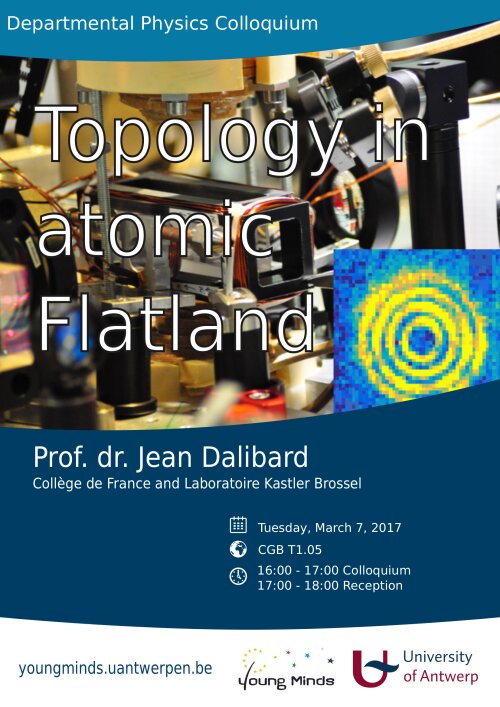
Pictures
The pictures of the event are available on Flickr.
2016-09-29 Eva Y. Andrei - The Physics of Imperfect Graphene
It is our pleasure to announce the next Physics Colloquium. On Tuesday, May 17, 2016, Prof. dr. Eva Y. Andrei from Rutgers University will present a talk entitled "The Physics of Imperfect Graphene". The abstract and practical information are included below.
Speaker
Prof. dr. Eva Y. Andrei
Rutgers University
Title
The Physics of Imperfect Graphene
Abstract
Graphene in its pristine form has transformed our understanding of 2D electron systems, leading to fundamental discoveries and to the promise of important applications. In the colloquium, new and surprising phenomena that emerge when the perfect honeycomb lattice of graphene is disrupted will be presented. In particular, we will focus on the effects of single atom vacancies on graphene's electronic and magnetic properties as revealed by scanning tunneling microscopy and spectroscopy. These include the ability to charge the vacancy site into the supercritical regime where atomic collapse leads to the formation of an artificial atom and the observation of electrostatically controlled Kondo screening of the vacancy's magnetic moment.
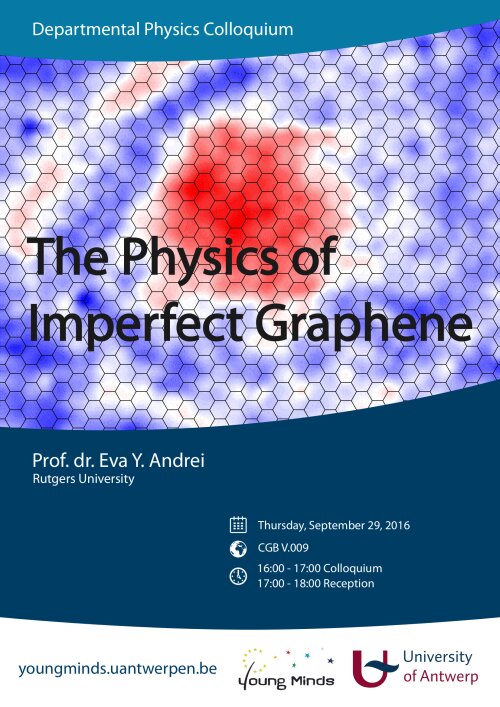
Pictures
The pictures of the event are available on Flickr.
2016-05-17 Thomas Hertog - The Discovery of Gravitational Waves
It is our pleasure to announce the next Physics Colloquium. On Tuesday, May 17, 2016, Prof. dr. Thomas Hertog from KU Leuven will present a talk entitled "The Discovery of Gravitational Waves". The abstract and practical information are included below.
Speaker
Prof. dr. Thomas Hertog
KU Leuven
Title
The Discovery of Gravitational Waves
Abstract
On 14 September 2015 at 10:51am an international team of scientists observed ripples in the fabric of spacetime, called gravitational waves, arriving at Earth from the merger of two black holes more than 1.3 billion years ago. This landmark discovery confirms a major prediction of Albert Einstein’s 1915 general theory of relativity and opens an unprecedented new window onto the cosmos that may well stretch all the way back to the big bang. In the colloquium, we will discover the significance of gravitational waves and what they can tell us about the universe.
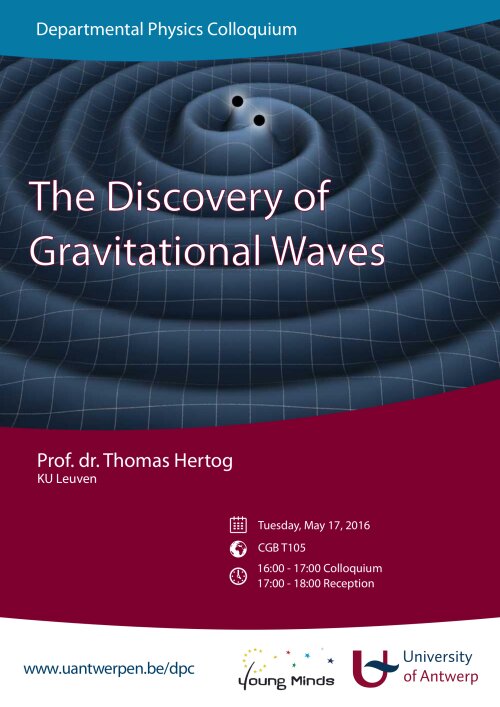
Video
This lecture was recorded and is available on YouTube.
Pictures
The pictures of the event are available on Flickr.
2015-12-17 Martin De Maziere - Tracking emission sources by remote sensing of the atmospheric composition
On December 17, UA alumna Dr. Martine De Maziere is giving a lecture on her research in aeronomy (the study of the upper atmosphere) as the Head of Department at the Belgian Institute for Space Aeronomy.
Speaker
Martin De Maziere
Belgian Institute for Space Aeronomy
Ghent University
Title
Tracking emission sources by remote sensing of the atmospheric composition
Abstract
The presentation will explain the principles of remote sensing of the atmospheric composition and its application to greenhouse gas and air quality measurements. Using inverse modeling techniques, we can derive so-called top-down emissions and make the distinction between various sources of emission like fires and human activity.
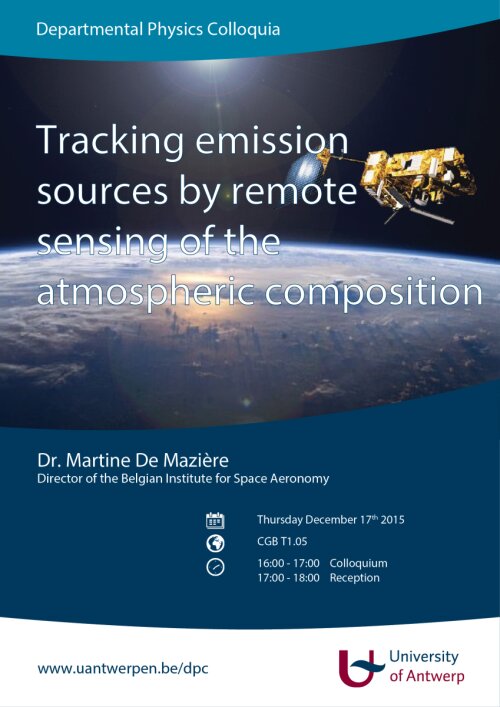
Video
This lecture was recorded and is available on YouTube.
Pictures
The pictures of the event are available on Flickr.
2015-10-20 Christian Van den Broeck - Thermodynamic Efficiency Revisited
On October 20th 2015, Prof. Dr. Christian Van den Broeck of Hassel University is giving a talk to the physics department on his research into thermodynamics.
Speaker
Prof. Dr. Christian Van den Broeck
Hasselt University
Title
Thermodynamic Efficiency Revisited
Abstract
We will review the definition of thermodynamic efficiency. Based on a new, generalised version of the second law of thermodynamics, we will derive universal features of the efficiency at maximum power and of the stochastic efficiency of small machines (sub-micron scale, e.g. Brownian motors and quantum dot photoelectric devices). We will subsequently revisit the implications for the Onsager symmetry.
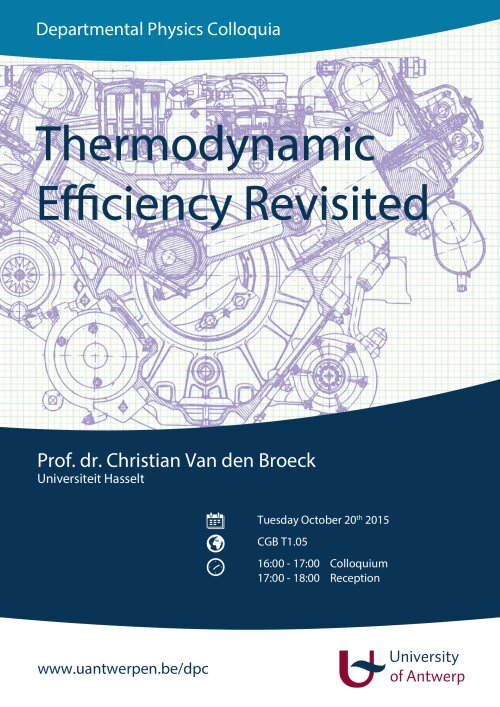
Pictures
The pictures of the event are available on Flickr.
2015-09-15 Richard D. James - New materials: real and imagined
On september 15th 2015, Prof. Dr. Richard James will give a departmental colloquium about his research into multiferroic materials.
Speaker
Prof. Dr. Richard D. James
University of Minnesota
Title
New materials: real and imagined
Abstract
In this talk I will give some examples of recently discovered materials that would have been considered unlikely a few years ago. They are crystalline materials that undergo strong first-order phase transformations and yet exhibit a high degree of reversibility and vanishingly small hysteresis. Some of these materials also exhibit "multiferroism”: abrupt changes of magnetization, or polarization, and strain at the transformation that suggest interesting applications to energy conversion. We also speculate on how to search in a systematic way for broad classes of interesting, yet undiscovered, nanoscale multiferroic materials.
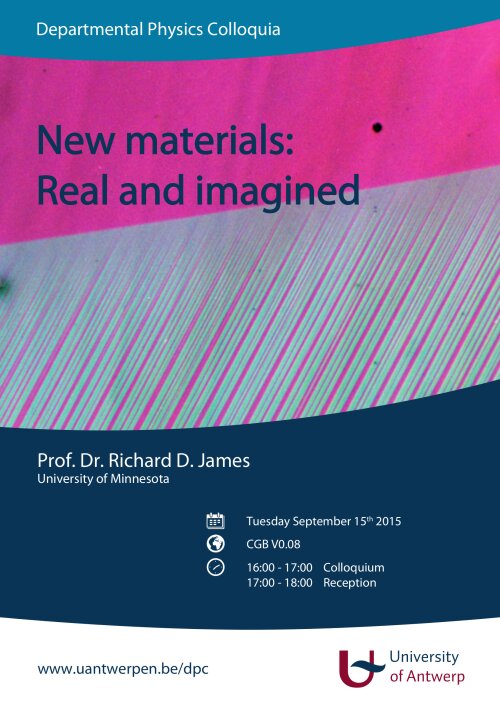
Video
This lecture was recorded and is available on YouTube.
Pictures
The pictures of the event are available on Flickr.
2015-03-31 Francis Halzen - IceCube and the Discovery of High-Energy Cosmic Neutrinos
On Tuesday March 31st 2015, we welcome Prof. Dr. Francis Halzen, who is the director of the IceCube experiment on Antarctica. He will give a talk about the IceCube neutrino detector and his work on cosmic neutrinos.
Speaker
Prof. Dr. Francis Halzen
Wisconsin IceCube Particle Astrophysics Center
Department of Physics, University of Wisconsin, Madison
Title
IceCube and the Discovery of High-Energy Cosmic Neutrinos
Abstract
The IceCube project has transformed one cubic kilometer of natural Antarctic ice into a neutrino detector. The instrument detects 100,000 neutrinos per year in the GeV to PeV energy range. Among those, we have recently isolated a flux of high-energy cosmic neutrinos. I will discuss the instrument, the analysis of the data, and the significance of the discovery of cosmic neutrinos.
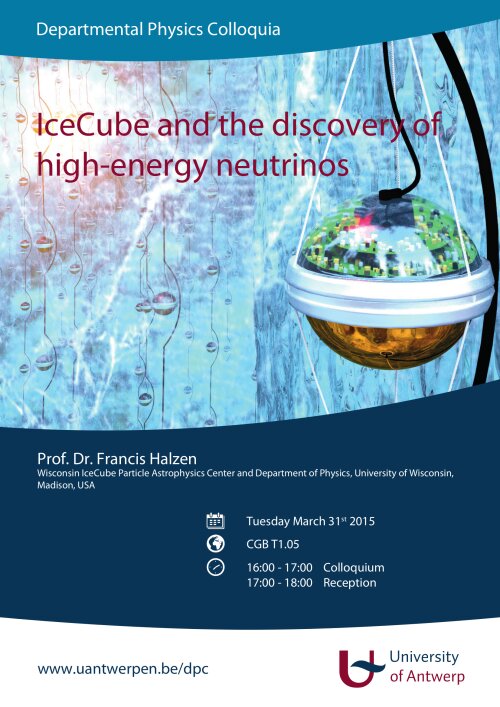
Video
This lecture was recorded and is available on YouTube.
Pictures
The pictures of the event are available on Flickr.
2015-02-20 Leo Kouwenhoven - The quest for Majorana particles
The physics department is excited to announce that Prof. Leo Kouwenhoven is giving a lecture about his recent experiments on Majorana fermions. Professor Kouwenhoven (TUDelft) is well known for his contributions on the experimental realization and detection of these exotic quasi-particles.
Speaker
Prof. Dr. Leo Kouwenhoven
QuTech and Kavli Institute of Nanoscience
Delft University of Technology
Title
The quest for Majorana particles
Abstract
Hunting for a new particle, not in a huge accelerator, but instead in a nanoscale electronic chip. The search for Majorana fermions stretches from detectors scanning the cosmos to the properties of special superconductors. These Majoranas have the mysterious property that they are equal to their anti-particles, which implies that they have zero spin, zero charge and zero energy. How to detect three times nothing? In this lecture, Leo Kouwenhoven will discuss their observation of the first signatures for the existence of Majoranas. Moreover, he will explain the connection between Majoranas and quantum computers.
Intersted students can find some introductionairy information into the subject on the 2Dphyics website.
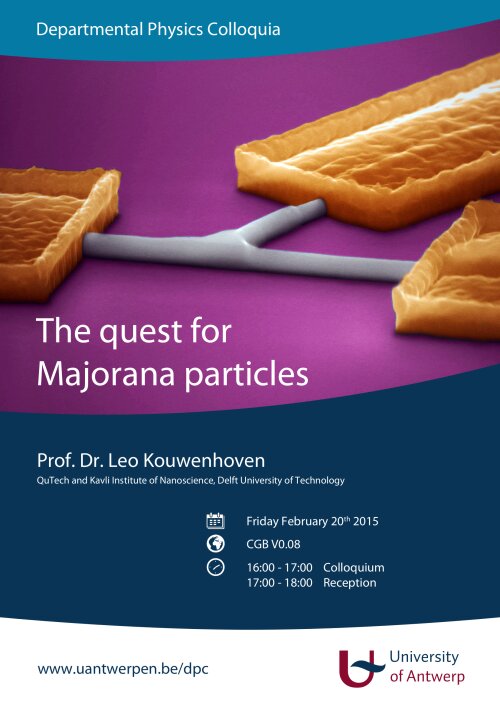
Video
This lecture was recorded and is available on YouTube.
Pictures
The pictures of the event are available on Flickr.
2014-11-27 Conny Aerts - Asteroseismology: the revolution in stellar physics
Speaker
Prof. Dr. Conny Aerts
Institute of Astronomy, KULeuven, Belgium
Department of Astrophysics, Radbound Universiteit Nijmegen, Netherlands
Title
Asteroseismology: the revolution in stellar physics
Abstract
The interiors of stars are not directly accessible for scientific experiment. This is problematic, because the life of stars, and by implication of galaxies in the Universe, is directed by the physical processes acting in their core regions. How do stars rotate internally? How do the products of nucleosynthesis mix inside stars? Do stars have an internal magnetic field? Thanks to the recent research domain of asteroseismology we can now start to answer these questions for various types of stars through interpretation of their oscillation frequencies. During the talk, we explain the basic principles of asteroseismology and we illustrate the immense advantage of having long-term uninterrupted high-precision data from space missions. We review the current status of the probing of stellar physics in general, and of the measurement of internal rotation and angular momentum in particular. We end with future prospects by highlighting the potential of asteroseismology as a tool in the study of galactic archaeology and of exoplanetary systems.
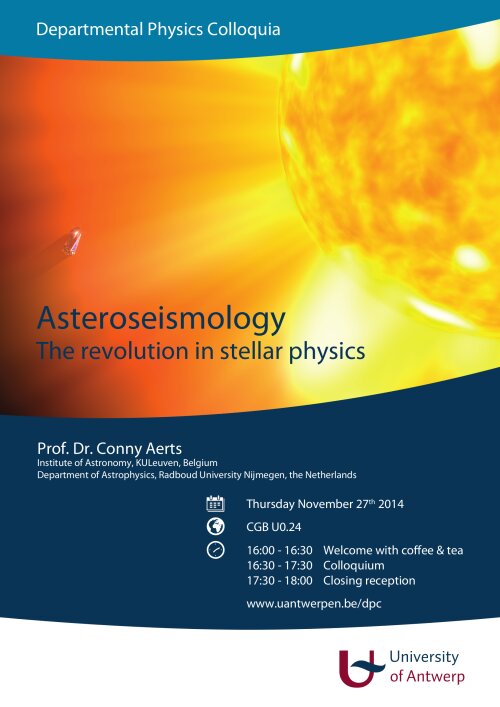
Video
This lecture was recorded and is available on YouTube.
Pictures
The pictures of the event are available on Flickr.